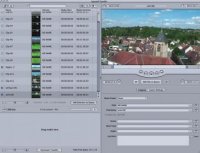MombasaFlash
Heli's & Tele's bloke
Following on from comments in another thread (Camera Mount Recommendations) regarding use of OIS and difficulties with previewing .mts files (AVCHD) the pic below shows the clips being previewed in Final Cut which were later used to assemble the video illustrating the difference between OIS on and OIS off.
View attachment 798
OIS is intended to reduce handheld camera shake and as such should be disabled for tripod use. Some like to include helicopters (inc. drones) in the 'tripod category', presumably because the camera is screwed down onto the gimbal camera plate.
I have never looked at it that way because I have yet to see a helicopter that flies like a tripod. They all come closer to the handheld category to me with the image shaking around to varying degrees according to the heli balance and setup and the pilot's abilities.
As such I have always utilised the OIS with the Panasonic HDC-SD9, starting with the Raptor 50. However, very occasionally I would do a really smooth flight and this of course antagonises OIS because it has nothing to do and so throws a little tantrum, delivering an unwarranted kick to the video image. But for the majority of the time the OIS is given plenty to do and therefore concentrates on that instead.
The linked video does a side by side (although not split-screen unfortunately because I haven't got time to work out how that's done) comparison of two flights with the Octo yesterday. One with OIS disabled and one with OIS enabled. The differences are sometimes subtle and the whole thing was made more complicated by a stiff breeze above the rooftops.
Apologies for the dark and dingy complexion of OIS-off. That is Panasonic's fault for boosting the camera screen brightness by default. I forgot to reduce it to normal when setting up exposure.
View attachment 798
OIS is intended to reduce handheld camera shake and as such should be disabled for tripod use. Some like to include helicopters (inc. drones) in the 'tripod category', presumably because the camera is screwed down onto the gimbal camera plate.
I have never looked at it that way because I have yet to see a helicopter that flies like a tripod. They all come closer to the handheld category to me with the image shaking around to varying degrees according to the heli balance and setup and the pilot's abilities.
As such I have always utilised the OIS with the Panasonic HDC-SD9, starting with the Raptor 50. However, very occasionally I would do a really smooth flight and this of course antagonises OIS because it has nothing to do and so throws a little tantrum, delivering an unwarranted kick to the video image. But for the majority of the time the OIS is given plenty to do and therefore concentrates on that instead.
The linked video does a side by side (although not split-screen unfortunately because I haven't got time to work out how that's done) comparison of two flights with the Octo yesterday. One with OIS disabled and one with OIS enabled. The differences are sometimes subtle and the whole thing was made more complicated by a stiff breeze above the rooftops.
Apologies for the dark and dingy complexion of OIS-off. That is Panasonic's fault for boosting the camera screen brightness by default. I forgot to reduce it to normal when setting up exposure.
Attachments
Last edited by a moderator:

